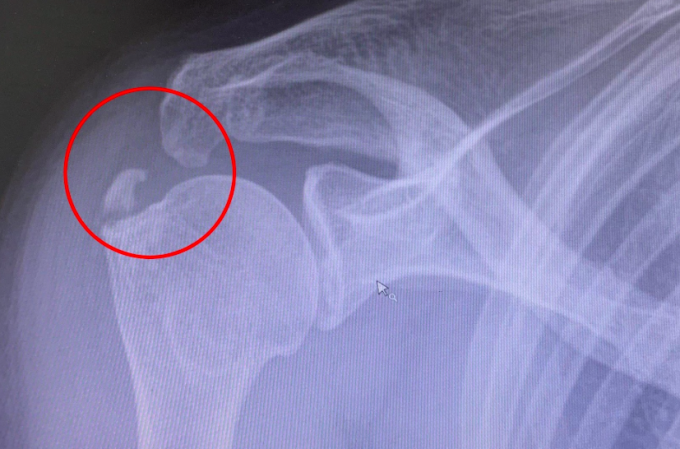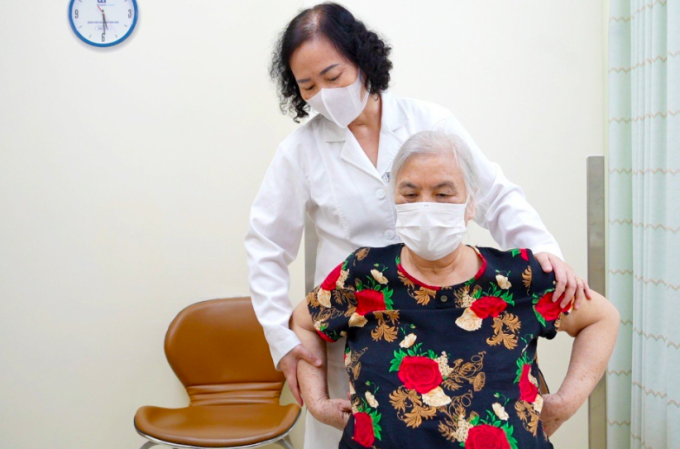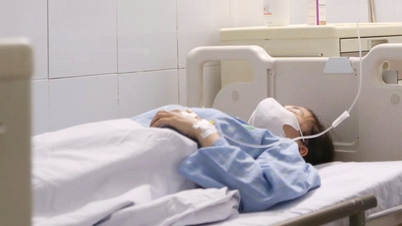The woman's right shoulder pain increased and she went to the doctor and was diagnosed with calcific tendonitis, a disease caused by calcium deposits in the shoulder joint.
Mrs. Tran Thi Chuyen (77 years old, Hanoi ) had pain in her right shoulder for many days. The pain gradually increased, causing her to lose sleep and lose the ability to move her shoulder joint. Even touching her shoulder or raising her arm caused pain. The acute pain made it almost impossible for the patient to move her right arm or perform normal movements.
At the end of April, when she visited Tam Anh General Hospital in Hanoi, Dr. Nguyen Thi Kim Loan, Department of Musculoskeletal, said that the test results and imaging diagnosis concluded that the patient had acute calcific tendonitis. The disease is caused by calcium deposits accumulating inside the muscles or tendons, causing pain and discomfort when moving. The most common location is in the rotator cuff area, where there are muscle groups and tendons responsible for movement in the arm and shoulder area.

The image on the film shows the patient's calcific tendonitis. Photo: Tam Anh General Hospital
Dr. Loan prescribed anti-inflammatory drugs, performed ultrasound-guided aspiration and joint injection. Aspiration of calcification is a minimally invasive method with high treatment effectiveness.
The patient was anesthetized in the rotator cuff area and a needle was used to make a small hole in the skin. Under the guidance of an ultrasound machine, the doctor directed the needle to the correct location of the calcification, aspirated the entire calcium mass and injected local anti-inflammatory drugs. After a week of treatment, Ms. Chuyen's mobility improved significantly and her pain was significantly reduced.
Calcifying tendonitis has 4 stages: pre-calcification, calcification, calcification and post-calcification. Stages 3 and 4 are due to the process of calcification occurring due to the body releasing calcifying enzymes, the patient experiences severe, persistent pain. Most cases of calcific tendonitis are due to aging. The accumulation of calcium deposits causing calcific tendonitis is often due to osteoarthritis, trauma, necrosis of the joint area or due to the patient having chronic diseases such as diabetes, gout, kidney...

The patient recovered and had significant pain relief after one week of treatment. Photo : Tam Anh General Hospital
People at risk of the disease such as women, people over 60 years old with osteoarthritis, people with metabolic diseases... should do gentle exercises to help restore shoulder movement, have a scientific lifestyle, and have regular check-ups as prescribed by the doctor to detect the disease early.
Calcific tendinitis can be cured. If detected late and not treated properly, the patient may experience complications such as tendon rupture, joint necrosis, local bleeding, rotator cuff tear, and shoulder immobility.
Therefore, Dr. Loan recommends that when acute pain occurs, the pain gradually increases and does not go away, the patient should see a doctor immediately. The doctor will determine the stage of the disease, thereby providing an effective treatment regimen, improving the patient's mobility and quality of life.
Emerald
Source link




























































































Comment (0)